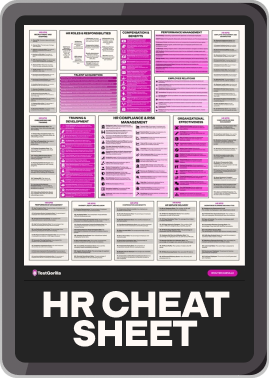How HR can foster a positive workplace culture for cubicle workers
If your office has a cubicle layout, you may find it challenging to ensure an open and collaborative workplace culture. After all, a small, enclosed cubicle can be uninspiring and unstimulating, leading to dissatisfaction and boredom among your staff – all of which are unlikely to foster a positive workplace culture.
To remedy and enhance your employees’ working week, you may have considered different methods to build a positive work culture for your team.
But if you haven’t found any ideal solutions so far, don’t stress. Check out the steps in this article to create a positive working environment.
What does cubicle work mean?
Cubicle work refers to work that takes place in small, enclosed spaces with low partition walls within an office. The partitions are intended to isolate team members and ensure workers do not get distracted by noises or interruptions from their colleagues.
What are the cons of working in a cubicle?
Cubicles can lead to team members feeling claustrophobic and that they lack space. This can be demoralizing, but it also often results in poorer quality work as employees are unlikely to excel if they feel uncomfortable and hemmed in.
Cubicle working is generally isolating and leads to reduced collaboration; team members may feel that they are alone in a tiny cubicle, and miss out on the chance to interact and collaborate with their colleagues.
Office managers are keen to replace cubicles with open spaces to reduce feelings of isolation and improve collaborative working.
Open office layouts are more likely to encourage teamwork, which may be lacking in a cubicle environment. Since cubicles prevent easy collaboration or face-to-face discussions between co-workers, many cubicle workers communicate via email or other communication channels – or else choose not to communicate with their team at all.
Unlike open office layouts, cubicle office environments may also hinder transparency and reduce output. In a cubicle, your team members may be less productive and more inclined to engage in unproductive activities, such as browsing the internet, if they consider these behaviors less visible to the wider team.
The best insights on HR and recruitment, delivered to your inbox.
Biweekly updates. No spam. Unsubscribe any time.
What do studies on working in cubicles say?
Several studies on working in cubicles have shown that employees who worked in a common space were more productive and experienced lower levels of stress than those working in separate cubicles.
These studies demonstrate that moving around in an open office space can increase employees’ physical activity and reduce physiological stress.
Another academic study found that interaction and workspace satisfaction across teams increased after redesigning a cellular office and creating an activity-based flexible office.
Not every open-plan office is the same, and inconsistencies in the layout of each office mean that findings are also inconsistent. Therefore, it is important to come up with a specific solution suitable for your team.
What seems clear, however, is that a chance to work in an open-plan setup tends to create more productive workers. What this looks like can differ from place to place, as some workers would much prefer cubicles or walls to compartmentalize open space while most studies show that higher degrees of interaction were associated with open-plan offices.
The evidence suggests, then, that it is well worth considering methods that foster a positive culture for cubicle workers.
4 ways to enhance your workplace culture for cubicle workers
If cubicle working environments are the only option for your workplace, there’s no need to worry: There are several actions you can take to mitigate its negative effects and help your team thrive.
Consider the following four ways to improve your cubicle working culture.
1. Foster a transparent environment
Although cubicles may prevent openness and transparency, you can still foster a transparent environment by cultivating an open workplace ethos. Begin by building a foundation of trust between team members using up-to-date technology and innovative communication tools.
The best communication channels will encourage your team to share ideas, building trust between co-workers.
You may also foster a transparent environment by encouraging teams to talk about their challenges in the workplace. Although it may not be necessary for them to discuss every small issue related to their complex projects, combining ideas and remaining open about the difficulties they face can help with transparency.
2. Enhance and foster better team relationships
Since working in cubicles can cause team members to feel isolated, enhancing better team relationships is important. Better relationships between team members will increase employee engagement and enhance productivity. Team-building activities are one effective method for cultivating better team relationships.
For example, you may establish a shared space where team members can eat lunch, getting them out of their cubicles and offering a chance to collaborate face-to-face.
You can also encourage your team to participate in virtual meetings by posting icebreaker questions or prompts or arranging frequent retrospectives to discuss this month’s complex projects or tasks.
3. Provide and ask for frequent feedback
Although working in cubicles reduces the opportunities for face-to-face discussions, creating spaces for teams to offer and receive regular feedback can help people working in cubicles thrive. Studies show that providing and asking for frequent feedback enhances employee engagement.
Offering and receiving feedback is a great way to improve your employees’ productivity and goal-setting approach. You may think that annual performance reviews mean you can check the “frequent feedback” checkbox with no other action needed, but this level of feedback is often insufficient for employees.
Instead, arranging one-to-one meetings or inviting team members to complete employee engagement questionnaires can help you share and receive feedback.
4. Arrange mentorships for learning and development
Giving feedback to newly hired employees can involve setting up mentorships that encourage interaction between team members. Mentorships can enhance the learning and development process and encourage the mentor and mentee to share feedback, which is a great way to avoid the isolation workers may encounter when working in cubicles.
One easy but important step for arranging mentorships is to use skill tests, such as our Leadership and People Management test, to review your potential mentor’s skills. Once you’ve reviewed the test results and determined which employees can influence and guide new hires, you can set up a mentorship.
Ensure your mentor interacts with and coaches your new hire, offering them sufficient support. This method will enhance your employee engagement and your team’s transparency and openness.
Foster a positive workplace culture for cubicle workers with TestGorilla
Fostering a positive workplace culture for cubicle workers may require you to overcome certain barriers, but it’s not impossible. The key to enhancing your workplace culture is to encourage communication between your team members.
Feedback and communication are crucial, and mentorships and coaching are excellent methods to make sharing feedback with your team easier. Ensure you review your potential mentors’ skills using skill tests before arranging a mentorship, and remember to encourage open and transparent communication.
Even in cubicle-based offices, there are still plenty of opportunities to create and enhance a positive culture. Sign up to TestGorilla today to help you achieve this.
You've scrolled this far
Why not try TestGorilla for free, and see what happens when you put skills first.















